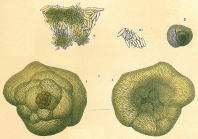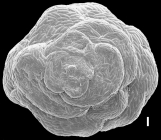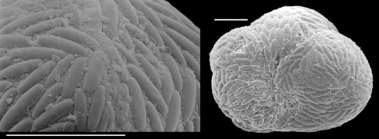WoRMS taxon details
Carterina Brady, 1884
415165 (urn:lsid:marinespecies.org:taxname:415165)
accepted
Genus
Rotalia spiculotesta Carter, 1877 accepted as Carterina spiculotesta (Carter, 1877) (type by monotypy)
marine, brackish, fresh, terrestrial
recent + fossil
feminine
Brady, H. B. (1884). Report on the Foraminifera dredged by H.M.S. Challenger during the Years 1873-1876. <em>Report on the Scientific Results of the Voyage of H.M.S. Challenger during the years 1873–76. Zoology.</em> 9 (part 22): i-xxi, 1-814; pl. 1-115., available online at http://www.19thcenturyscience.org/HMSC/HMSC-Reports/Zool-22/htm/doc.html
page(s): p. 66, 345 [details]
page(s): p. 66, 345 [details]
Hayward, B.W.; Le Coze, F.; Vachard, D.; Gross, O. (2024). World Foraminifera Database. Carterina Brady, 1884. Accessed through: World Register of Marine Species at: https://www.marinespecies.org/aphia.php?p=taxdetails&id=415165 on 2024-04-19
Date
action
by
2009-09-23 14:01:30Z
created
db_admin
![]() The webpage text is licensed under a Creative Commons Attribution 4.0 License
The webpage text is licensed under a Creative Commons Attribution 4.0 License
original description
Brady, H. B. (1884). Report on the Foraminifera dredged by H.M.S. Challenger during the Years 1873-1876. <em>Report on the Scientific Results of the Voyage of H.M.S. Challenger during the years 1873–76. Zoology.</em> 9 (part 22): i-xxi, 1-814; pl. 1-115., available online at http://www.19thcenturyscience.org/HMSC/HMSC-Reports/Zool-22/htm/doc.html
page(s): p. 66, 345 [details]
additional source Loeblich, A. R.; Tappan, H. (1987). Foraminiferal Genera and their Classification. Van Nostrand Reinhold Company, New York. 970pp., available online at https://books.google.pt/books?id=n_BqCQAAQBAJ [details] Available for editors [request]
[request]
additional source Pawlowski, J.; Holzmann, M.; Debenay, J.-P. (2014). Molecular phylogeny of Carterina spiculotests and related species from New Caledonia. <em>The Journal of Foraminiferal Research.</em> 44(4): 440-450., available online at https://www.researchgate.net/publication/280772297 [details] Available for editors [request]
[request]
page(s): p. 66, 345 [details]
additional source Loeblich, A. R.; Tappan, H. (1987). Foraminiferal Genera and their Classification. Van Nostrand Reinhold Company, New York. 970pp., available online at https://books.google.pt/books?id=n_BqCQAAQBAJ [details] Available for editors
additional source Pawlowski, J.; Holzmann, M.; Debenay, J.-P. (2014). Molecular phylogeny of Carterina spiculotests and related species from New Caledonia. <em>The Journal of Foraminiferal Research.</em> 44(4): 440-450., available online at https://www.researchgate.net/publication/280772297 [details] Available for editors
From editor or global species database
Diagnosis Test probably free-living in the early stage, later attached to the substrate, large flattened specimens with numerous rapidly enlarging and progressively more crescentic to irregular trochospirally coiled chambers may represent the microspheric generation, and the surrounding spreading flange may be a reproductive structure; after about two whorls infolding of both the organic lining and spicular layer of the wall may form radial secondary septula, or chamber subdivision may be delayed and later chambers have an undulating surface of alternately inflated and constricted areas around the circumference, each undulation provided with a separate umbilica1 aperture like those of the chamberlets; wall imperforate, with a thick organic inner lining that imparts a distinctive brown color to the first one or two whorls, covered by an outer layer of calcareous fusiform to rodlike secreted calcite spicules with concentrically layered structure, held in a ground mass of smaller but similar spicules, spiral side may have an inner layer of spicules aligned approximately perpendicular to the test periphery and a surface layer of spicules arranged parallel to the periphery or in somewhat chevronlike arrangement, spicules of progressively larger size in later chambers, tiny spicules also line the interior and fill the space between larger ones, umbilical side against the attachment has a single layer of spicules in parallel groups of a few spicules but of more random orientation than on the spiral side, spreading flange also covered with spicules and apertural region may have a mass of spicules; aperture umbilical in position, single in the early chambers, multiple in the expanded later chambers, with separate umbilical openings from each lobe or chamberlet of the final whorl. U. Eocene: Spain; Holocene: cosmopolitan in tropical shallow water. (Loeblich & Tappan, 1987, Foraminiferal Genera and Their Classification) [details]


